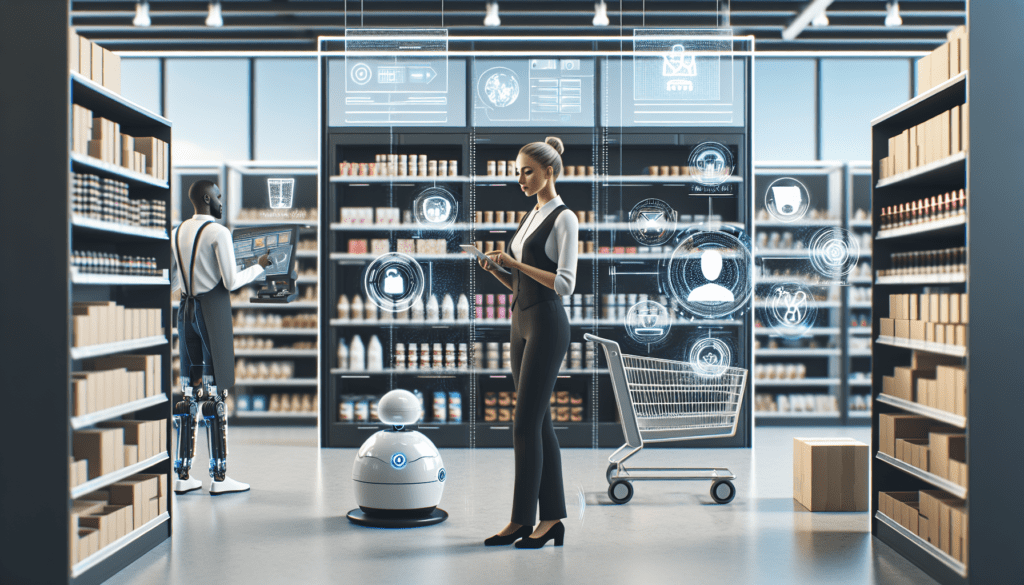Augmented Reality in Retail
Embracing AR technology for marketing strategies is revolutionizing the retail industry by making shopping interactive and enhancing customer engagement. Through the immersive experiences offered by AR, brands can create a dynamic and personalized shopping journey, ultimately increasing customer satisfaction and loyalty.
Making Shopping Interactive
Consumers today seek unique and interactive shopping experiences. Embracing augmented reality in retail allows brands to fulfill this demand. Studies have shown that 40% of consumers express a willingness to pay more for a product that they can customize using AR. By integrating AR technology into their marketing strategies, retailers can transform traditional shopping into a captivating and interactive experience, regardless of the location.
Virtual try-on experiences have become a cornerstone of the e-commerce landscape, with many retail brands incorporating virtual fitting room applications into their flagship shopping apps. This technology enables customers to visualize products, such as clothing and accessories, in a virtual space, enhancing their understanding of fit and style (MobiDev). For example, Nike has successfully implemented AR and VR elements in their physical stores, providing customers with immersive experiences like virtual product scanning and VR tours of their supply chain.
Augmented reality has paved the way for a new era of engaging and interactive shopping experiences, allowing brands to connect with consumers on a deeper level through innovative digital interactions. To explore how augmented reality can elevate your retail experience, visit our article on ar advertising for companies.
Enhancing Customer Engagement
Incorporating AR technology into retail operations not only boosts customer engagement but also drives sales and brand loyalty. Retailers are leveraging the power of AR/VR to optimize customer interactions and streamline operations across diverse industries, with retail, healthcare, and entertainment at the forefront of AR adoption.
The impact of AR on purchasing decisions and sales potential cannot be underestimated. By offering customers virtual try-on experiences, personalized recommendations, and opportunities for cross-selling, retailers using AR technology can significantly influence conversion rates and overall sales. AR enhances the shopping experience by providing reassurance on style, size, and fit preferences, ultimately leading to increased customer satisfaction and loyalty.
The market for AR technology is rapidly expanding, with significant investments being made in AR devices and services worldwide. Financial resources dedicated to AR technology are projected to reach $340 billion by 2028 (CGSinc). Consumers are displaying a growing preference for retailers that offer augmented reality experiences, highlighting the importance of integrating AR capabilities into retail strategies.
By tapping into the potential of augmented reality, retailers can create memorable and interactive shopping experiences that resonate with consumers, foster brand loyalty, and drive long-term success in the evolving retail landscape. To delve deeper into successful examples of AR implementation in retail, explore our article on ar for product visualization.
Benefits of AR in Retail
In the realm of retail, the integration of AR technology brings forth a multitude of advantages, both for businesses and consumers. Utilizing AR in retail not only enhances the shopping experience but also contributes to boosting sales potential and fostering brand loyalty.
Increased Sales Potential
When AR is incorporated into the retail landscape, it unlocks a realm of possibilities for driving sales. By providing customers with interactive and immersive experiences, companies can significantly increase their conversion rates. Interacting with products through AR experiences results in a 94% higher conversion rate in retail, enabling individuals to better assess products and feel connected with the brand. This heightened level of engagement leads to a more informed purchasing decision, ultimately translating to enhanced sales figures.
Moreover, the implementation of augmented reality technology has shown to increase conversion rates by up to 2x and reduce returns by 40% in the retail industry. By offering customers a dynamic and interactive way to explore products, businesses can create a shopping experience that is not only seamless but also captivating, driving higher sales potential and customer satisfaction.
Building Brand Loyalty
In addition to driving sales, AR plays a vital role in building brand loyalty within the retail sector. By incorporating AR technology into marketing strategies and product visualization, businesses can create unique and memorable experiences for their customers. These experiences go beyond traditional shopping interactions, fostering a deeper connection between consumers and the brand.
Statistics indicate that 71% of shoppers express a likelihood to shop more frequently when using AR-powered apps, showcasing the positive impact of AR on customer engagement and loyalty (Netguru). Furthermore, 40% of consumers are willing to pay more for a product if they have the opportunity to test it in AR, highlighting the potential for AR to not only enhance sales but also cultivate loyal brand advocates.
As businesses continue to harness the power of AR in retail, they stand to gain not only increased sales potential but also a devoted customer base that values the immersive and personalized experiences offered through augmented reality. By leveraging AR technology effectively, companies can elevate their brand presence, establish lasting relationships with customers, and stay at the forefront of innovation in the competitive retail landscape.
Statistics and Market Trends
As we delve into the realm of AR in retail industry, it’s essential to understand the growth projections and consumer preferences shaping the landscape.
Growth Projections
The adoption of augmented reality technology is on a rapid upward trajectory. By 2024, the number of mobile AR users is anticipated to soar to an impressive 1.73 billion (Fingent). This substantial user base presents a significant opportunity for retailers to leverage AR experiences and transform the shopping journey for consumers.
Furthermore, retail is poised to emerge as a leading sector driving the AR/VR market forward. According to IDC, spending in retail is projected to constitute 85% of the total world spending on AR/VR by the end of 2021. This considerable investment underscores the industry’s recognition of the potential of augmented reality to revolutionize the retail experience and drive business growth.
Consumer Preferences
Consumer behavior is undergoing a paradigm shift, with augmented reality playing a pivotal role in shaping shopping experiences. A noteworthy 32% of consumers have already embraced AR while shopping, highlighting the growing interest and acceptance of AR technology in the retail space.
Moreover, consumer sentiment toward AR in retail is overwhelmingly positive, with 71% of consumers expressing that they would shop more frequently if AR features were integrated into their shopping experiences (Fingent). This marked consumer desire for AR-powered shopping encounters underscores the enormous potential for retailers to enhance customer engagement and drive sales through immersive and interactive AR experiences.
Understanding the growth projections and consumer preferences surrounding AR in the retail realm is crucial for businesses looking to leverage this innovative technology to elevate their marketing strategies, increase customer engagement, and stay ahead in the competitive retail landscape.
Implementation Challenges
When delving into the realm of implementing AR in the retail industry, several challenges must be considered to ensure a seamless integration of augmented reality technology. Let’s explore two critical hurdles that businesses may face during the implementation process: cost considerations and resource allocation concerns.
Cost Considerations
One of the primary challenges associated with implementing AR technology in retail is the financial investment required. The price tag for AR implementation can vary significantly depending on the scope and complexity of the project. As reported by CGSinc, the cost of creating an AR application akin to IKEA’s could range between $30,000 to $60,000, based on prevailing rates for AR app developers.
Moreover, the creation of 3D models for products and scanning products for these models can incur additional costs. Generally, developing 3D models for products falls in the range of $150 to $350 per product, while scanning products for 3D models can vary from $300 to $500 per product, contingent on complexity. These financial considerations highlight the importance of conducting a comprehensive cost analysis before embarking on an AR implementation journey.
Resource Allocation Concerns
In addition to cost considerations, resource allocation poses another significant challenge for businesses venturing into AR integration. While the allure of augmented reality for product visualization and other applications is compelling, dedicating the necessary human and technological resources is essential for successful implementation.
Some companies may struggle with sourcing skilled professionals capable of developing AR content and applications. Moreover, maintaining these resources for ongoing AR initiatives can be a persistent challenge. Businesses must assess their internal capabilities and explore partnerships or outsourcing options to address resource gaps effectively.
Striking a balance between financial investments, personnel training, and technological infrastructure is crucial to overcoming resource allocation concerns linked to AR implementation. By carefully evaluating the skill sets needed and ensuring ongoing support for AR initiatives, businesses can navigate these challenges and unlock the full potential of augmented reality in the retail landscape.
Successful Examples in Retail
In the realm of retail, augmented reality (AR) has revolutionized the shopping experience by offering innovative solutions that drive engagement and boost sales. Two key examples of successful AR implementations in retail include virtual try-on experiences and collaborations with tech giants.
Virtual Try-On Experiences
Virtual try-on experiences powered by AR technology have significantly transformed the way customers interact with products and make purchasing decisions. Retailers leveraging AR for virtual try-on solutions have observed remarkable results:
- The utilization of AR in virtual try-on experiences has been shown to increase conversion rates by up to 2x and reduce returns by 40% in the retail industry (VNTANA).
- Clothing stores have witnessed improvements in conversion rates and reductions in returns through the implementation of features like virtual fitting rooms, leading to enhanced online conversion rates and increased profitability.
- Customers exhibit a higher propensity to purchase products they can virtually try out hassle-free using AR, thereby driving up sales and engagement levels.
- Virtual try-on experiences enable customers to digitally try on clothes and products before making a purchase, resulting in a significant decrease in returns and a boost in customer engagement within the retail sector.
- The retail industry has witnessed a surge in the development of virtual try-on solutions, with over 53,000 patents related to this technology being filed by retailers in the past three years, indicating a growing trend in the adoption of AR virtual try-on solutions.
Collaborations with Tech Giants
Collaborations between retail brands and tech giants have paved the way for groundbreaking AR applications that redefine the customer shopping experience. Several notable collaborations include:
- Nike’s integration of augmented reality and virtual reality in their physical stores, allowing customers to scan items to access information and experience virtual tours of Nike’s supply chain, providing transparency and enhancing the shopping journey.
- IKEA’s creation of The Place App, enabling shoppers to utilize augmented reality through their smartphone cameras to visualize furniture items within their living spaces, facilitating informed purchasing decisions with a virtual preview of products in real-life settings (Forbes).
- L’Oreal’s collaboration with Facebook to offer augmented reality-powered makeup try-on experiences, enabling customers to experiment with renowned beauty brands and virtually try on makeup products, enhancing the online shopping experience and brand engagement.
- WatchBox’s use of AR technology to allow customers to try on various sizes of luxury watches virtually, aiding in selecting the perfect timepiece and visualizing its appearance on their wrist before purchase.
- Toms’ integration of virtual reality in stores worldwide, transporting customers to different locations to experience the impact of their charity initiatives firsthand, demonstrating the power of immersive experiences in driving brand engagement and social responsibility.
These successful examples illustrate the transformative potential of AR in retail, showcasing how virtual try-on experiences and collaborations with tech giants can elevate customer engagement, enhance brand loyalty, and drive sales growth in the dynamic landscape of retail business.


